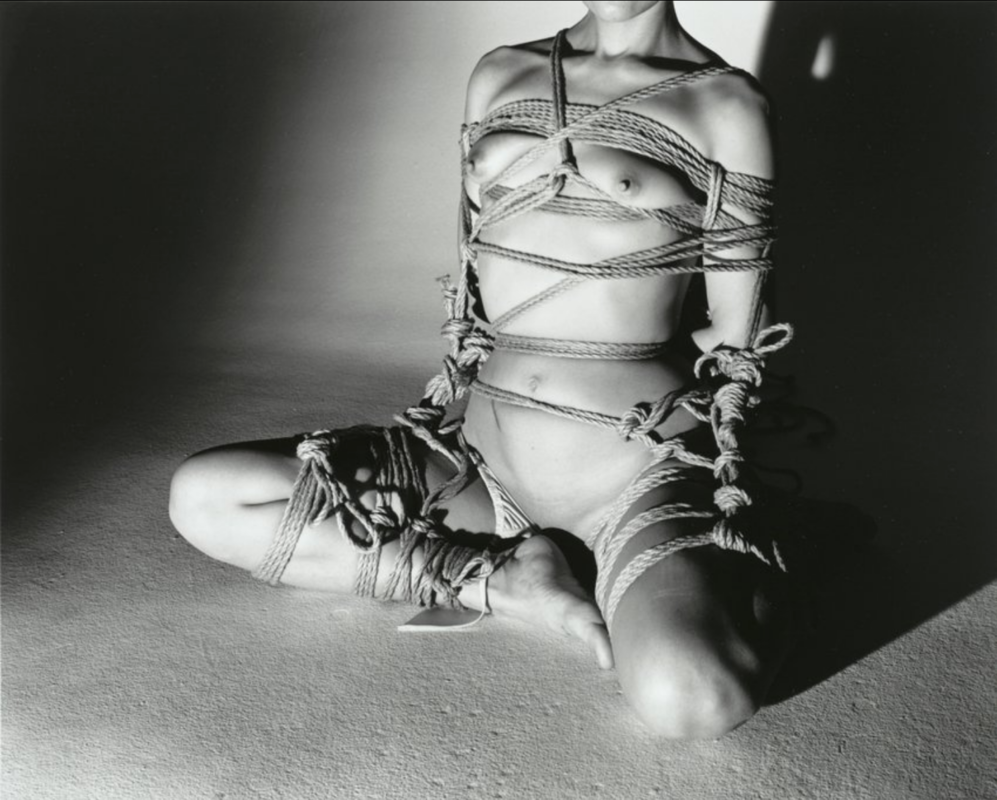More about Kinbaku (Bondage)

Contributor
Nobuyoshi Araki’s Kinbaku (Bondage) walks the line (or rope, in this case) between misogynistic pornography and the artful interest in Kinbaku-bi or “the beauty of tight binding.”
The art of kinbaku is rooted in Feudal Edo era torture and punishment by the samurai class. The practice was then called hojojutsu and it was highly effective in the extraction of confessions from prisoners, and in displaying the consequences of criminal activity. Captives would be tied in a way that was legibly symbolic of their crime, which is both morally repugnant and kinda cool. Luckily for Nobuyoshi’s models, kinbaku has come a long way and is now a far cry from its torturous roots in hojojutsu.
After the elimination of the samurai class in Japan in the mid- to late-1800s, kabuki theater got a hold of the idea of bondage and started using it on stage. You can only imagine the disappointment of the samurais in seeing their art of torturous knot tying left to the drama kids. Obviously, the actors toned down the torture aspect of it a bit and made it more ~artistic~. They made the knots simpler, easier to perform in front of an audience, and harder to watch for the ousted samurai, who by then were probably contemplating seppuku (Japanese ritual suicide to bring honor back to oneself).
After the exciting days of theater, kinbaku made its way into the hearts of kink connoisseurs. It was always kind of a thing, as you can see from artworks like The Dream of the Fisherman’s Wife by Katsushika Hokusai (tentacles = bondage), but it became a means of sexual pleasure that people actually studied somewhere around the 1950s. This is where Nobuyoshi Araki came in. His piece, Kinbaku (Bondage) is just one example of a myriad of photos Nobuyoshi has taken of women in bondage over the years. Believe it or not, it’s on the PG side relatively speaking, despite the fact that her nips and her bajingo (almost) are visible. This woman is in the average 20 feet of knotted rope, which seems a little overkill if you ask me. As if she would be able to escape even 5 feet of rope…but 20? My god. Also the fact that she’s naked is no help to her ability to escape. Where is Harry Houdini when we need him?
If kinbaku seems traumatic to you, rest assured that this is a consensual practice and the nawashi (rope masters) are well versed in pleasure, not torture. Despite the incredible backlash and censorship that Nobuyoshi Araki received for his art, Kinbaku is now very much an integrated part of both Japanese and Western society. If you don’t believe me, look up #kinbaku on Instagram for over 130,000 mildly alarming posts on the subject.
Sources
- Bache, Pauline. "Sex, Bondage And Death: Nobuyoshi Araki Documents Intimate Instances." Phaidon. Web. 12 Mar. 2018.
- "Nobuyoshi Araki, Kinbaku (Bondage), 1979; Printed 2008." SFMOMA. Web. 12 Mar. 2018.
- Sehayek, Marnie. "[NSFW] A Brief History Of Japanese Rope Bondage." Creators. N.p., 2017. Web. 12 Mar. 2018.
- Woodward, Daisy. "Nobuyoshi Araki And The Art Of Bondage." AnOther. N.p., 2012. Web. 12 Mar. 2018.











